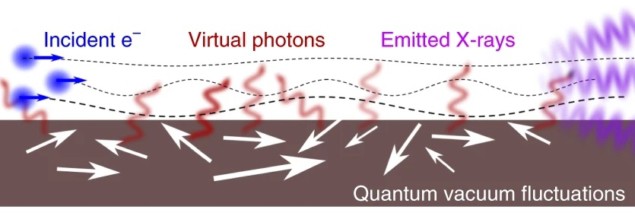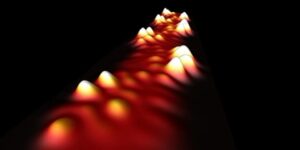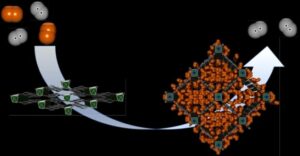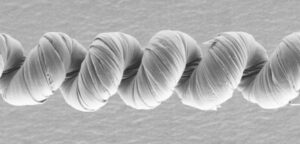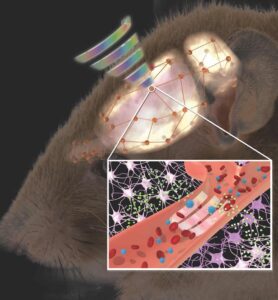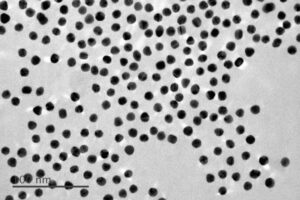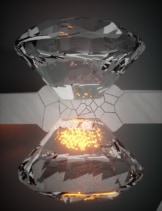
Vacuum fluctuations just a few nanometres from the surface of a material can cause a passing beam of relativistic electrons to emit X-rays and other high-frequency electromagnetic radiation — according to calculations done by scientists in the US, Israel and Singapore. If confirmed experimentally, the effect could be used to create compact and tunable sources of X-rays and even gamma rays.
Compact sources of high-quality electromagnetic radiation at X-ray and higher frequencies are difficult to make because electrons in materials cannot react quickly enough to electromagnetic field oscillations at these high frequencies. Instead, production of such radiation relies on strong external fields that accelerate beams of high-energy electrons in devices such as synchrotrons and free-electron lasers. While this approach has been extremely successful, it requires huge and expensive magnets or lasers, and can only be done at a handful of dedicated sites.
Now, Nicholas Rivera and colleagues at the Massachusetts Institute of Technology, Technion and Nanyang Technological University in Singapore, have proposed a new way of generating high-frequency light that does not require strong external fields. It involves a two-photon process whereby a relativistic free electron passing a few nanometers from the surface of a material spontaneously emits a high-energy photon and a polariton. The latter is a quasiparticle that forms as a result of interaction and mixing of light with dipoles in a medium. The cause of this spontaneous emission are vacuum fluctuations, a well-known phenomenon that arises because the vacuum is not empty space, but has a non-zero energy density of the electromagnetic field.
Famous effects
“The most famous effects arising from vacuum fluctuations are the Casimir and van der Waals forces between neutral objects, the latter of which explains the ability of geckos to walk on ceilings”, adds Rivera. These so-called vacuum forces are especially strong in the nanoscale vicinity of nanophotonic structures.
Rivera and colleagues did calculations of this effect in optical materials such as graphene; thin films of gold and silver; and silicon carbide. In these materials polaritons are emitted at infrared or visible frequencies. Using doped graphene increases the strength of the van der Waals force that extracts more emission from the electron. The calculated photon emission is more broadband than in synchrotrons, spanning from soft ultraviolet to hard X-ray frequencies, explains Ido Kaminer. Furthermore, the team calculated that the total emitted power is comparable to the power that equal-energy electrons would emit as synchrotron light induced by a 1 T magnetic field, a mind-blowing theoretical prediction.
The concept could be used to develop compact and tunable sources of high-frequency light, based on vacuum fluctuations near and inside nanophotonic materials. But what material will provide the desirable radiation characteristics?
Higher coherence and shorter pulses
Kaminer says: “We expect certain periodic patterns, as is now often done in metasurfaces, to result in higher coherence and shorter pulses”. Gigaelectronvolt electron beams could be delivered by a conventional linear accelerator, or perhaps in the future by a more compact laser wakefield accelerator. The framework could be extended to include more complex electron-beam configurations such as moving dipoles or bunched electrons – the latter is used in free-electron lasers.

Compact synchrotron is unveiled
Ultimately, by using the tools of nanophotonics, controlling high-frequency light emission may lead to creation of synthetic active nonlinearities at X-ray and even gamma-ray frequencies. Such nonlinearities could be used, for example, to create entangled pairs of X-ray photons via parametric down conversion.
Full details of the research are reported in Nature Physics, where the team also makes several suggestions for how the effect could be studied in the lab.
- SEO Powered Content & PR Distribution. Get Amplified Today.
- PlatoData.Network Vertical Generative Ai. Empower Yourself. Access Here.
- PlatoAiStream. Web3 Intelligence. Knowledge Amplified. Access Here.
- PlatoESG. Automotive / EVs, Carbon, CleanTech, Energy, Environment, Solar, Waste Management. Access Here.
- BlockOffsets. Modernizing Environmental Offset Ownership. Access Here.
- Source: https://physicsworld.com/a/electrons-passing-over-nanophotonic-materials-could-create-synchrotron-like-light/
- :has
- :is
- :not
- :where
- 1
- 216
- 90
- a
- ability
- AC
- accelerate
- accelerator
- According
- active
- Adds
- also
- and
- approach
- ARE
- AS
- At
- based
- BE
- Beam
- because
- been
- between
- broadband
- but
- by
- calculated
- CAN
- cannot
- Cause
- certain
- characteristics
- colleagues
- comparable
- complex
- concept
- CONFIRMED
- controlling
- conventional
- could
- create
- creation
- dedicated
- delivered
- density
- details
- develop
- Devices
- DID
- difficult
- does
- done
- down
- E&T
- effect
- effects
- electrons
- emission
- energy
- energy density
- enough
- especially
- Even
- example
- expect
- expensive
- Explains
- external
- Extracts
- extremely
- famous
- few
- field
- Fields
- films
- fluctuations
- For
- Force
- Forces
- forms
- Framework
- Free
- from
- Furthermore
- future
- Gamma rays
- generate
- generating
- Gold
- Graphene
- handful
- Hard
- Have
- High
- High-Frequency
- high-quality
- higher
- How
- http
- HTTPS
- huge
- if
- image
- in
- include
- Increases
- information
- inside
- instead
- Institute
- interaction
- Israel
- issue
- IT
- jpg
- just
- lab
- laser
- lasers
- lead
- light
- Magnetic field
- Magnets
- make
- MAKES
- massachusetts
- Massachusetts Institute of technology
- material
- materials
- max-width
- May..
- medium
- MIT
- Mixing
- more
- most
- moving
- Nanophotonics
- Nature
- Near
- Neutral
- New
- now
- objects
- of
- often
- on
- only
- or
- Other
- over
- pairs
- Passing
- passive
- patterns
- perhaps
- periodic
- phenomenon
- Photons
- Physics
- Physics World
- plato
- Plato Data Intelligence
- PlatoData
- power
- prediction
- process
- Production
- proposed
- provide
- quickly
- Radiation
- React
- Reported
- require
- requires
- research
- result
- says
- scientists
- scripts
- several
- Silicon
- silicon carbide
- Silver
- Singapore
- Sites
- Soft
- Sources
- Space
- strength
- strong
- studied
- successful
- such
- Surface
- synthetic
- team
- technological
- Technology
- than
- that
- The
- The Future
- theoretical
- These
- this
- thumbnail
- to
- tools
- Total
- true
- university
- us
- used
- using
- Vacuum
- via
- visible
- Way..
- well-known
- What
- which
- while
- Wikipedia
- will
- with
- world
- would
- x-ray
- zephyrnet

